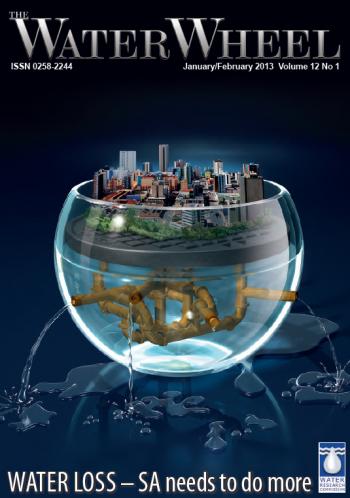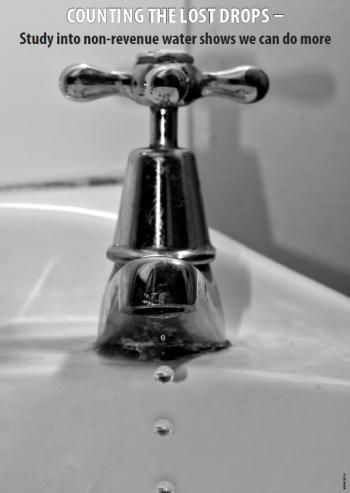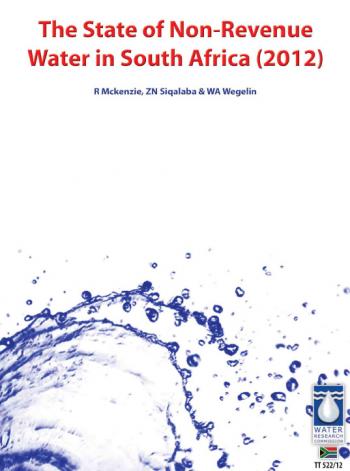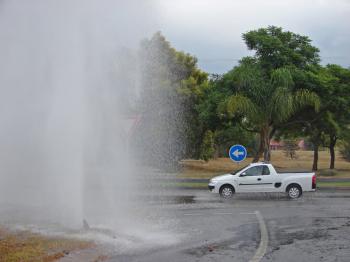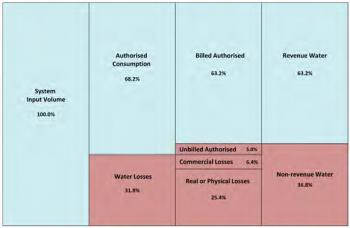Counting the Last Drops
While South Africa’s non-revenue water levels compare well internationally as a water scarce country we need to do all we can to prevent the unnecessary loss of water. This is one of the main recommendations of a recent study into the state of non-revenue water in South Africa commissioned by the Water Research Commission (WRC). Lani van Vuuren reports.
The Draft Second National Water Resources Strategy (NWRS2) has identified the implementation of water use efficiency, conservation and water demand management as a core strategy to ensure sufficient water to meet South Africa’s needs going into the future. This, ‘non-negotiable performance area’, it says, must be implemented immediately in all water use sectors, specifically municipalities. “In view of water scarcity, it is essential that such water losses must be curtailed, especially in terms of the need to provide for the growing water demands of new socio-economic development,” the strategy points out.
In order to improve the current situation, the water sector must have a clear indication of the current status of non-revenue water in South African municipalities, more specifically what the actual water losses are and how they are split between physical leakage (real losses) and commercial losses (apparent losses). It is for this reason that the WRC, in collaboration with the Department of Water Affairs (DWA), launched the latest investigation into the state of non-revenue water in South Africa, which has now been published.
In the most comprehensive and detailed study of its kind, to date, data were gathered from 132 municipalities throughout South Africa representing over 75% of the total volume of municipal water supply. The study follows on from similar WRC assessments undertaken in 2001, 2005 and 2007. This is the first time the country has a single, representative estimate of non-revenue water as opposed to various estimates in previous years.
According to project leader and MD of WRP Consulting Engineers, Ronnie Mckenzie, speaking on behalf of the key team members, which included Willem Wegelin and Zama Siqalaba who gathered most of the information, many of the country’s municipalities are realising the value of undertaking a proper and reliable water balance. They were therefore happy to cooperate with the project team as it also helped them to formalise their water balance, a requirement of DWA.
“Unfortunately we also have several municipalities operating in crisis mode, who had no energy to deal with requests for information,” adds Mckenzie. More than half of municipalities were unable to provide any data on non-revenue water, and many lacked even the most basic bulk meter readings, which means they do not know how much water they are consuming let alone how much is being lost through physical leakage or commercial losses. This was of great concern to the project team.
MAIN RESULTS
South Africa’s present level of non-revenue water is estimated to be in the order of 37%, which is virtually at the world average of 36,6%. Of this, a quarter is considered to be losses through physical leakage. According to Mckenzie, while South Africa compares well to the world average we do not compare well to other developed water scarce countries, such as Australia, whose non-revenue water levels are often less than 10%. “There is still much scope for improvement. As a water scarce country we cannot afford to waste so much water.”
The study also indicates that South Africa still has a relatively high per capita water use (around 273 litres per person per day) which is an indication that the average citizen still does not realise the scarcity of this resource. The current volume of nonrevenue water is around 1 580 million m3/annum of water per annum – roughly equal to the annual supply of Africa’s largest water utility, Rand Water. At a nominal production cost of R4,5/m3, this loss represents about R7,2-billion a year.
It is heartening to note that the issue of non-revenue water – ignored by many municipalities in the past – is now receiving increasing attention at municipal level. “All of the large metros and most of the large cities and towns are now monitoring their water use and trying to establish a proper and reliable water balance in line with international recommendations,” notes Mckenzie. “Progress in this regard is certainly being made and both the DWA and the WRC are creating awareness and encouraging proper water auditing at the municipal level.”
So-called category A municipalities (metros) achieved non-revenue water levels of around 34,3% compared to the water losses of 72,5% (on average) achieved by B4 (small) municipalities. Non-revenue water levels of mid-sized municipalities range from 30,5% to 41,3% on average. Mckenzie does stress that expressing the losses in terms of percentages, while normal practice at the political level, can be very misleading and care should be exercised when comparing percentage losses between different municipalities or from one year to the next.
In many municipalities throughout South Africa there is a dedicated effort to provide safe potable water to outlying communities that have previously had no access to a formal water supply indicating a shift in focus from improving efficiency to the installation of new pipelines and supplies in line with government policy. As the report points out, such measures can inadvertently lead to an increase in the levels of non-revenue water, particularly in percentage terms, when, in fact, significant improvements are often being made.
THE CHALLENGES REMAIN
Unfortunately, despite the progress being made, it seems that South Africa’s non-revenue water levels have remained stagnant at best over the past five to ten years. “It appears that the overall level of nonrevenue water throughout South Africa is not reducing, with indications that it may in fact be increasing,” says Mckenzie. “Unfortunately, it is currently not clear whether the slight increase is due to more reliable data from a larger data set or due to a real increase in the non-revenue water. We require another year or two of reliable data to establish if the trend is really increasing or not.”
The investigation confirmed that non-revenue water remains the product of many factors, including poor planning, limited financial resources to implement the necessary programmes, poor infrastructure asset maintenance and lack of capacity. However, several additional key problem areas were also identified. One of the greatest inhibitors to the introduction of successful water demand management in many municipalities is the proper auditing and documentation of the various interventions.
“If the various interventions are properly ring-fenced and audited, the results will speak for themselves and the funding needed to implement new projects will easily be approved,” notes Mckenzie. “Such auditing will also deter many companies from undertaken non-revenue water reduction projects under the misconception that they are an easy source of income and can be completed by anyone with a spade and a shovel.”
Another important aspect of nonrevenue water reduction is effective billing and metering. Revenue recovery is essential in order for municipalities to provide a sustainable good quality service and as such should be decisively implemented across the country where practicable, the report points out. Ultimately, local authorities have a mandate to generate revenue and to operate in a self-sustaining manner and this can only be achieved through proper monitoring of water-supply systems in the form of metering and creating a culture of payment for services to enable sound maintenance activities and a high standard of consumer service. Furthermore, the importance of proper planning, budgeting and maintenance of water infrastructure cannot be over-emphasised and is essential in reducing water losses and averting a potential water crisis.
WHAT SHOULD OUR TARGETS BE?
Non-revenue water can potentially have a significant impact on water supply, and in some areas high levels of lost water have already forced the commissioning of new transfer schemes. According to Mckenzie, non-revenue water should be seen as a source of water as it actually represents a significant opportunity for municipalities to save water. “The added bonus is that many of the interventions needed to reduce non-revenue water can be implemented at relatively modest cost compared to those of a new water-supply project.”
Moreover, in areas that typically experience high levels of unemployment, the water demand management measures can create useful and long-term employment. In many cases, such interventions not only save water but can also create significant energy savings, particularly in systems where water is pumped at some point in the supply cycle.
While the NWRS2 sets a target to reduce non-revenue water in municipalities to 15% by 2014, Mckenzie suggests that this may be difficult to achieve without the injection of many billions of Rand into the necessary water demand management interventions countrywide within the next two years. Without such a massive financial investment he believes that a target of 25% within ten years is achievable, especially considering muncipalities’ current resources. Mckenzie also recommends that targets be defined in terms of volumes rather than percentages, as the latter can be misleading.
“While it may still be possible to achieve significant savings within only a few years this will require huge investment which may simply not be viable in the current economic climate in which many countries across the globe are struggling just to survive. We know that it takes ten to twenty years to implement a new water resource project and water loss reduction projects are likely to need the same time period for proper and sustainable implementation.” Adds Mckenzie: “There will always be some water demand management interventions that can be implemented quickly and costeffectively. Such interventions should be prioritised and implemented without delay.”
While some municipalities have made great strides in conserving water much still has to be done in other areas to ensure water is not wasted unnecessarily. It is hoped that water loss reduction will receive the attention it deserves before the next large drought hits the country.
- To order the report, The State of Non-Revenue Water in South Africa (Report No. TT 512/12), contact Publications at Tel: (012) 330-340; Fax (012) 331-2565; Email: orders@wrc.org.za or Visit: www.wrc.org.za to download a free copy.
